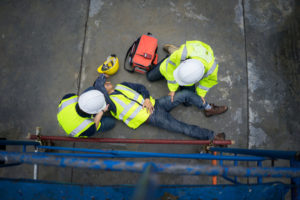Construction sites offer a hotbed of potential dangers. Many construction workers end up working in dangerous situations, some knowingly, others with no idea of the hazards they face as they move around a job site.
Construction companies generally bear a high duty of care to ensure that their workers do not face unnecessary dangers as they move around those job sites. Unfortunately, when the construction company fails in its duty of care to its workers, it can lead to catastrophic injuries. Following a construction accident injury, the best thing one can do is to contact a construction accident lawyer immediately.
Some types of injuries occur more commonly on construction sites than others.
Falls
 Falls are the leading cause of death on construction sites. According to the CDC, fall deaths make up more than a third of the total number of fatalities in the industry.
Falls are the leading cause of death on construction sites. According to the CDC, fall deaths make up more than a third of the total number of fatalities in the industry.
Falls on construction sites can occur because of several common acts of negligence.
Trip and Fall Accidents
Construction sites may have many trip hazards. Despite efforts to clean up the site at the end of each shift, some workers may leave their tools lying around. Other workers may struggle with trip hazards like cords or broken boards in their path. Unfortunately, those trip hazards can, in many cases, pose a substantial danger since they can make it very difficult to navigate safely. When those trip hazards occur at heights, they can pose even more danger.
Falls From Heights
On a construction site, workers need to take all possible protections to avoid falls from heights. That may mean guardrails, toe-boards, or clear markings around holes. Unfortunately, construction sites may not always have those protections in place. Furthermore, some construction sites may have unexpected hazards, or construction workers may not have time to get protections in place before a fall occurs.
Construction workers may also work at heights regularly. Construction workers across the country need to work on roofs, balconies, and other potentially dangerous settings.
Dangerous or Damaged Ladders
Construction workers use ladders regularly. Those ladders can help them get to areas higher on the building or allow them to reach things they cannot reach from the ground.
Unsafe ladders, however, can mean serious concerns, including an immense risk of injury. Not only do ladders need to sit in safe areas where they will not tip over, but construction companies also need to carefully inspect their ladders regularly to ensure they do not pose an unnecessary danger to their workers. A damaged ladder can tip over or break, resulting in severe injury to the user.
Inadequate or Damaged Fall Protection
Construction companies must provide their workers with fall protection to help protect against fall injuries. Depending on where workers need to work, that may include harnesses and ropes that will help reduce the risk of an accident.
Unfortunately, some construction companies, especially those who do not have their workers work at those heights regularly, may not provide adequate fall protection. In other cases, workers may choose not to use fall protection, assuming they will not face serious hazards or can complete a task more quickly if they do not bother with those fall protection items.
Damaged Surfaces
Construction workers often work on buildings that need repair. That may mean buildings with damaged roofs or floors. Unfortunately, construction workers often do not know the full extent of the damage until they get into the project. Workers may walk across damaged flooring or roofing without noting the potential danger. Those damaged surfaces can collapse underfoot, leading to serious fall injuries.
Struck-by Accidents
According to the CDC, struck-by accidents, which make up around 15.4 percent of construction site fatalities, are the second most common cause of death on construction sites. Struck-by accidents can occur in several ways:
Heavy Equipment With Inadequate Visibility
Many big pieces of equipment often used on construction sites have very large blind spots, making it difficult for operators to see what takes place around them. Due to those blind spots, operators may have difficulty avoiding potential hazards, including people who may not move out of the way. Properly clearing the area and issuing warnings when heavy equipment use occurs can help reduce the risk of an accident.
Falling Objects
Falling objects can pose a potential danger on many construction sites. Construction workers often need to work at different heights at the same time to get the work on the building completed in a timely manner. Unfortunately, workers on the ground or at lower points in the building may face a high risk of items falling off the building and striking them. Depending on the falling object or the speed at which the object falls, those injuries can prove fatal.
Dangerous Driving Behavior
Struck-by accidents may include dangerous behavior behind the wheel of a vehicle. Often, vehicles move over construction sites without the need for roads or other guidelines. Unfortunately, that means that people may end up in a vehicle’s path, leading to serious injury or even death.
Construction workers may also use vehicles off the job site, regularly picking up and transporting materials or driving to other job sites. Dangerous behavior on the road, including speeding, distracted driving, and driving while intoxicated, can all raise the risk of a devastating collision, including a struck-by accident that can result in severe injuries or even death.
Electrocutions
Electrocutions, the CDC notes, make up around 7.2 percent of construction site deaths. Many construction projects either involve electrical work directly or working around electrical lines.
Failing to Properly Identify Electrical Lines Before Digging
Sometimes, construction workers may fail to properly identify the locations of electrical lines before digging. In many counties, construction companies must wait for a government team to come out and identify those lines before they can start the construction process. Sometimes, they may deal with significant delays, which may interfere with the project’s overall timeline or make it more difficult for workers to get their jobs done. In other cases, construction companies may decide they do not want to pay for necessary permits or inspections and get started without waiting.
When construction workers start digging or breaking up concrete without approval, they may encounter electrical lines unexpectedly, which can result in electrical burns and other electrocution injuries.
Electrical Lines Left Exposed
Sometimes, construction workers need to take on many electrical tasks as they manage the job site. Those tasks may include work by a certified electrician or a general contractor, depending on the type of work needed. However, other workers on the site may not know about the potential dangers offered by those electrical lines, especially if the site lacks adequate warnings. Leaving electrical lines exposed can mean a substantial hazard for everyone in the area.
Electricity and Water Combined
Construction workers try to avoid letting open electrical lines be exposed to water. However, dangers may arise if the construction workers do not take adequate precautions. Water may come into contact with electricity due to dripping water, broken pipes, or failure to properly secure electrical lines.
Failure to Warn Other Workers
Electricians may know to avoid certain areas during the normal course of their work. However, other workers on the job site may not know about those potential risks. As a result, those workers may come into contact with the exposed electrical wires. Proper warnings may decrease those risks and make workers across the job site safer.
Mistakenly Turning Electricity Back On
Electricians frequently cut power to certain areas before beginning any electrical work. Cutting the electricity can decrease the risk of an accident while working on electrical lines within the building. However, sometimes, another worker might mistakenly turn the electricity back on, leading to a serious electrical burn or shock risk for the person working on those lines.
Faulty Wiring
Faulty wiring in a building can pose many potential hazards, including substantially increased fire hazards. Construction workers working around that faulty wiring may face a higher risk of electrocution or electrical burns. In many cases, construction workers may not know those potential hazards until an injury occurs.
Caught In/Between Accidents
The CDC notes that those caught in or between accidents account for around 5.4 percent of construction site deaths. Many times, construction workers work with a variety of tools and in dangerous situations that have the potential to cause caught in or between accidents.
Crushing Damage from Heavy Equipment
Many construction sites involve considerable heavy equipment. Workers may start to take that heavy equipment for granted and fail to take proper precautions around it. Crushing damage from heavy equipment can cause immense, devastating injuries, including limb amputation.
Slipping Between Pieces of Equipment
Sometimes, construction workers can find themselves trapped between two pieces of equipment. Workers may deliberately attempt to reach between two pieces of equipment or mistakenly end up sliding into those areas. Caught in/between accidents can result from moving equipment or because construction workers attempt to move around items that should be stationary.
Moving Equipment or Supplies on the Job Site
As equipment and supplies move around a job site, construction workers may need to get out of the way quickly. In many cases, however, workers may suddenly find themselves trapped by heavy moving equipment. Workers may, in those cases, end up trapped between moving pieces of equipment, leading to serious injury.
Getting Stuck Inside Small Areas or Equipment
Sometimes, construction workers may reach into small or tight areas without taking adequate precautions. As they reach into those areas, they may discover a tighter fit than they thought. Sometimes, getting stuck inside tight areas or equipment can lead to devastating, crushing injuries.
After an Injury on a Construction Site: Protecting Your Right to Compensation
 Construction sites have many potential hazards, making it little wonder that construction work is one of the most dangerous occupations.
Construction sites have many potential hazards, making it little wonder that construction work is one of the most dangerous occupations.
If you suffer injuries on a construction site as a worker or a visitor, taking steps to protect your right to compensation can prove critical.
- Review the company’s policy for reporting injuries. Make sure you fill out any necessary paperwork and issue any necessary reports as soon as possible.
- Let a doctor evaluate the full extent of even seemingly minor injuries. Do not avoid going to the doctor after a construction site accident. If you do not see a doctor immediately after the accident, see a doctor once you notice that you have ongoing injury symptoms.
- Contact a lawyer to learn more about your right to compensation. Often, construction site accidents mean filing a workers’ comp claim. However, in some cases, you may have the right to file an injury claim against a party whose negligence caused your injuries.
- Follow your care provider’s instructions. That may mean avoiding going back to work until you have a chance to recover from your injuries or making sure that you make necessary appointments.
- Let your lawyer deal with the insurance company for you. Insurance companies may try to avoid accepting liability for your accident, and you want to ensure you do not miss out on the compensation you deserve.
Dealing with the insurance company after any construction accident, whether you need to file a workers’ comp or injury claim, can be incredibly stressful. Contact a lawyer as soon after your construction accident as possible to get the support you need to move forward with your claim as effectively as possible.
